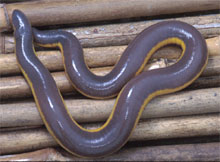Ichthyophiidae |
58 species in 2 genera
Commonly Called Asian Caecilians, Fish Caecilians, Asian Tailed Caecilians
Ichthyophis bannanicus
Photo by Nikolai Orlov
(Click for family gallery)Ichthyophiids can be diagnosed by the combination of partial external division of the atrium and a long anterior pericardial space. These caecilians have true tails (like rhinatrematids) with caudal vertebrae, generally a counter-sunk lower jaw, an advanced dual jaw closing mechanism and primary annuli subdivided by secondary and sometimes tertiary annuli (absent in the genus Uraeotyphlus). Annuli in some species are straight posteriorly but angled anteriorly when viewed ventrally. Dermal scales are found in annular grooves. The tentacular opening lies between the nostrils and the eye or closer to the eye, or anterior on the snout below the nostril (as in Uraeotyphlus). Unlike rhinatrematids, ichthyophiid skulls are more solidly roofed (stegokrotaphic). The mouth may be terminal or subterminal. Members of this family may reach 500 mm, with the smallest species at 135 mm total length. Clutches are laid in moist soil or a burrow near water (ponds or streams). Females attend their clutches until larvae emerge to complete their metamorphosis in water.
Much is still unknown about the natural history of these species.
Ichthyophiids are found in South and Southeast Asia. The family Ichthyophiidae has undergone some taxonomic revision, and now includes Uraeotyphlus, formerly placed in its own family (see Wilkinson et al. 2011).
Written by AmphibiaWebNotable Family Characteristics
- Fossorial, Terrestrial
- Occurs in a variety of habitat, primary and secondary forests, agricultural fields or plantings (e.g., tea plantations)
- Adults have a true tail although short with caudal vertebrae
- Eggs are laid in moist soil or underground chambers near water where the female cares for the eggs until the larvae hatch. The gilled larvae then move to nearby water (standing or moving) to complete development
- Morphological features include: 1) distinct primary annuli, divided by secondary grooves; 2) generally a counter-sunk lower jaw, an advanced dual jaw closing mechanisml; 3) mouth terminal or subterminal; 4) dermal scales present in primary grooves; 5) skull solidly roofed (stegokrotaphic)
- Distribution limited to South and Southeast Asia

Cartography Credit: Zoe Yoo, UC Berkeley
Range maps sources: AmphibiaWeb, UC Berkeley, and IUCN RedListRelevant Reference
Wilkinson, M., San Mauro, D., Sherratt, E., and Gower, D. J. 2011. A nine-family classification of caecilians (Amphibia: Gymnophiona). Zootaxa 2874: 41-64.
Vitt, L. J., and J. P. Caldwell. 2013. Herpetology. An Introductory Biology of Amphibians and Reptiles. Fourth Edition. Amsterdam: Elsevier.
Genus Ichthyophis (51 species)
Ichthyophis acuminatus no account no photos no sound/video Ichthyophis alfredi account no photos no sound/video Ichthyophis asplenius account photos no sound/video Ichthyophis atricollaris no account no photos no sound/video Ichthyophis beddomei account photos no sound/video Ichthyophis benjii account photos no sound/video Ichthyophis bernisi no account no photos no sound/video Ichthyophis biangularis no account no photos no sound/video Ichthyophis billitonensis no account no photos no sound/video Ichthyophis bombayensis no account photos no sound/video Ichthyophis cardamomensis account no photos no sound/video Ichthyophis catlocensis no account no photos no sound/video Ichthyophis chaloensis no account no photos no sound/video Ichthyophis daribokensis no account no photos no sound/video Ichthyophis davidi account photos no sound/video Ichthyophis dulitensis no account no photos no sound/video Ichthyophis elongatus account photos no sound/video Ichthyophis garoensis no account no photos no sound/video Ichthyophis glandulosus no account no photos no sound/video Ichthyophis glutinosus no account photos no sound/video Ichthyophis humphreyi no account no photos no sound/video Ichthyophis hypocyaneus account no photos no sound/video Ichthyophis javanicus no account no photos no sound/video Ichthyophis khumhzi account no photos no sound/video Ichthyophis kodaguensis no account photos no sound/video Ichthyophis kohtaoensis account photos no sound/video Ichthyophis lakimi no account photos no sound/video Ichthyophis laosensis no account no photos no sound/video Ichthyophis larutensis no account no photos no sound/video Ichthyophis longicephalus account no photos no sound/video Ichthyophis mindanaoensis no account no photos no sound/video Ichthyophis monochrous no account no photos no sound/video Ichthyophis moustakius account no photos no sound/video Ichthyophis multicolor account photos no sound/video Ichthyophis nguyenorum account photos no sound/video Ichthyophis nigroflavus no account no photos no sound/video Ichthyophis nokrekensis no account no photos no sound/video Ichthyophis orthoplicatus no account photos no sound/video Ichthyophis paucidentulus no account no photos no sound/video Ichthyophis paucisulcus no account no photos no sound/video Ichthyophis pauli no account photos no sound/video Ichthyophis pseudangularis account photos no sound/video Ichthyophis sendenyu account no photos no sound/video Ichthyophis sikkimensis no account photos no sound/video Ichthyophis singaporensis no account no photos no sound/video Ichthyophis sumatranus no account no photos no sound/video Ichthyophis supachaii no account photos no sound/video Ichthyophis tricolor no account photos no sound/video Ichthyophis weberi account no photos no sound/video Ichthyophis yangi no account no photos no sound/video Ichthyophis youngorum no account no photos no sound/video
Genus Uraeotyphlus (7 species)
Uraeotyphlus gansi account no photos no sound/video Uraeotyphlus interruptus no account no photos no sound/video Uraeotyphlus malabaricus account no photos no sound/video Uraeotyphlus menoni account no photos no sound/video Uraeotyphlus narayani account no photos no sound/video Uraeotyphlus oommeni no account no photos no sound/video Uraeotyphlus oxyurus account no photos no sound/video
Citation: AmphibiaWeb: Information on amphibian biology and conservation. [web application]. Berkeley, California: AmphibiaWeb. Available: https://amphibiaweb.org/. (Accessed:
AmphibiaWeb's policy on data use.

